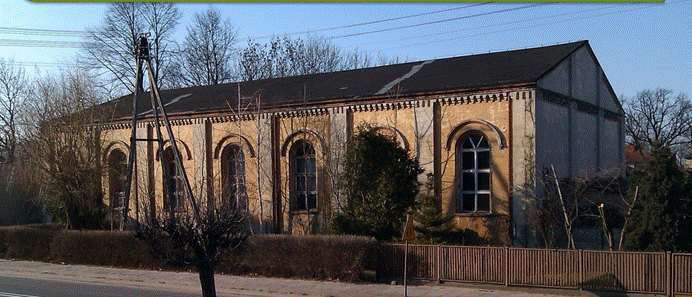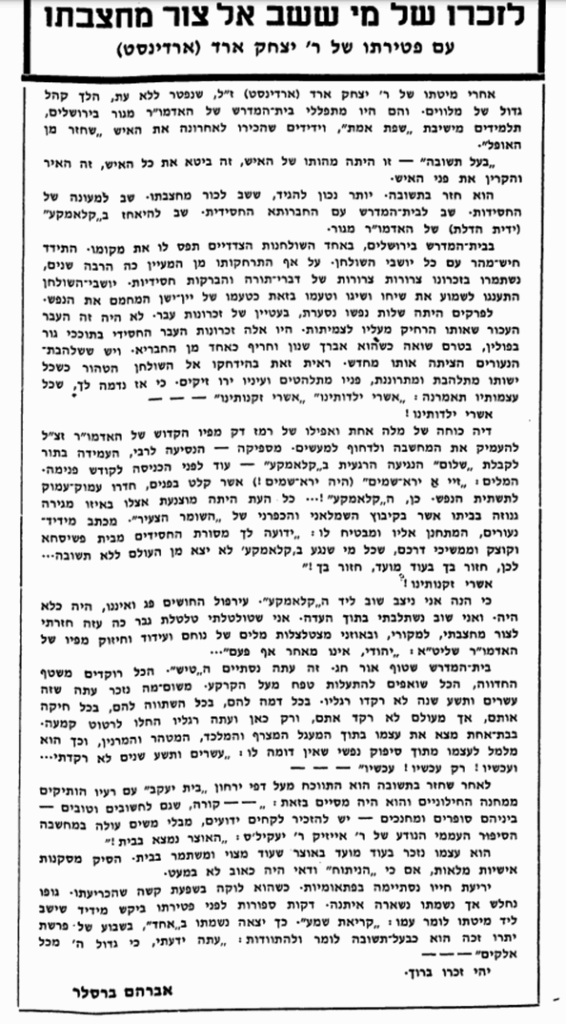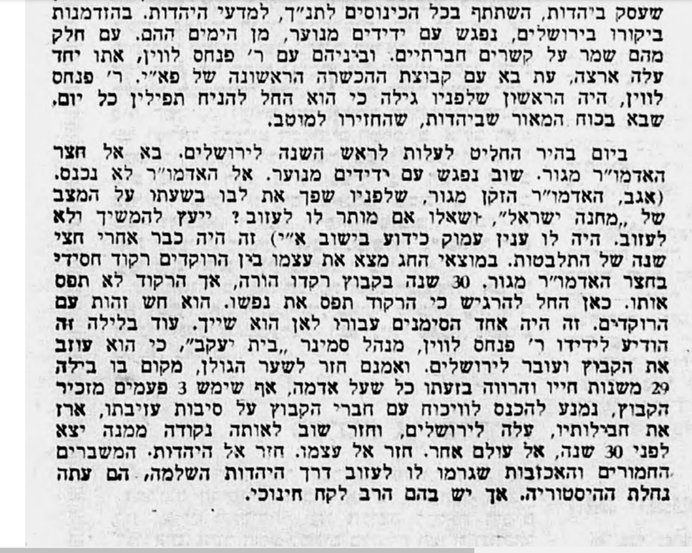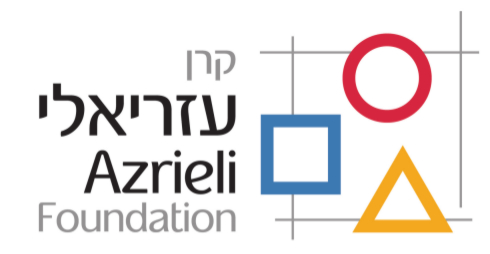Lututów – A Town that Was
By: Yaakov Rosenfeld
Not many people today know about the Polish town of Lutotów, in the Lodz province, not far from the German border, but it was a warm and joyous chassidic Jewish town, with a population of over 1,600 Jews.
Of the 1,600 Jews, only 20 survived. Most of them were killed, and even their names are unknown. Yad Vashem’s Pages of Testimony document only 207 names of Lutotów’s Jewish residents. May G-d avenge their blood.

The synagogue in Lutotów (Photo from the “Days of Lutotów magazine, published by the Lutotów municipality)
In the elections for the municipality of Lutotów, Agudath Israel won six seats, while another chassidic party, Alexander, won two additional seats. In 5683 (1923), Lutotów made headlines due to a blood libel committed by a young priest who was swimming in a swimming pool with two Jews. He demanded that they get out of the pool, and when they refused, he decided to publish that the boys had tried to drown him to death. This libel stirred up the town, and in the pogrom that followed on Shabbat, over a hundred Jewish residents of Lutotów and nearby towns were injured.


Jewish homes that were looted. A town that was.

The founding of the Agudath Israel Youth Movement in the city of Lutotów, Shavuot 5690 (1930)

A congratulatory message to Rabbi Tzvi Lenchitzki of Lutotów on the occasion of his appointment to the rabbinate in Bielsk. Among the signatories is Rabbi Shlomo Goldwitz, may G-d avenge his blood, the rabbi and scholar, who served as the gabbai (operations assistant) of the Ger Beit Chassidim (Shtiebel, small synagogue)
The notification was published in summer 5699 (1939), a few months before the war’s outbreak, in the Tagblatt newspaper.

The synagogue is currently used as a tailoring workshop (Courtesy of the Lutotów municipality)
In the Days of Wrath
In the early winter of 5700 (1940), 85 years ago, the Germans ordered the businessman Walman (father of Fruma Glatstein, excerpts from whose testimony will be included below) to collect valuables from Jewish homes, such as gold and diamonds. The man, with a warm and sensitive Jewish heart, refused to obey the order, and was therefore arrested along with other prominent members of the community. The Jewish community feared for his fate, especially in light of the murders that had already begun in this town immediately after the German occupation. Fortunately, though, Walman returned a few days later, albeit wounded and toothless, but alive. Thus the Nazis began to display their control through acts of terror and looting that struck fear into hearts and were a harbinger of things to come.
At the beginning of 1940, in the month of Shevat 5700, a few months after the town was conquered by the Nazis, a German soldier was killed in a forest near Lutotów as a result of a mine explosion. The place, which was strewn with mines planted by soldiers of the retreating Polish army, posed a significant threat to the German army forces that were patrolling the area, but they soon came up with an ingenious solution: Dozens of Jews from Lutotów were taken out of their homes and forced to walk back and forth through the mine-covered forest to neutralize the bombs, and by the grace of G-d, not a single mine exploded beneath them. A survivor from the town, Mrs. Fruma Glatstein (who passed away in 5750/1990) wrote in her memoirs about the town (in the Massuah and Yad Vashem archives) that the Charedi Jews saw the hand of G-d protecting them in this case, while the Nazis claimed that the Jews were practicing witchcraft, since after this act, mines continued to explode in the place and the Germans suffered losses there. The incident appears in other documentary sources about this town during the Holocaust as well.
Continuing her testimony, Fruma tells of the Seder night of 5701 (1941), when she sat at her home in Lutotów, together with her family, at the elegant Seder table, and which was held in the shadow of the horrors of those difficult days:
When my sister went out to open the door while reciting Shfoch Chamatcha (Pour Out Your Wrath), Nazis, wearing white robes stained with blood, burst into the house. They kidnapped my sister, and disappeared.
The next day, my sister returned and said that the Germans, who were on their way home for their holiday, had taken geese with them and for this purpose kidnapped Jewish girls from their homes so that they could pluck the feathers and clean the geese.
In her testimony, Fruma told of the visit to the town of German film producers from the “Opa” company, and of the nightmare they caused in the occupied town. Jews were forced, for the purposes of the film scenes, to beat each other and tear off each other’s peyos (sidelocks) and beards. All the elders in the town had their beards and peyos shorn off at that time, except for Rabbi Ber Yaakovowitz, the synagogue cantor, whose beard was particularly long and fine.
The climax of Fruma’s chilling testimony is the description of her last meeting with her father, may G-d avenge his blood.
He came to her and gave her a small bag, hugged her tightly and blessed her. He urged her to survive and flee to the Land of Israel, and indeed she was saved from the inferno and rebuilt her life in the Land of Israel. In the small bag were some coins and a small piece of paper on which her father wrote the priestly blessing: “May G-d bless you and keep you, may G-d make His face shine upon you and be gracious to you, may G-d lift up His face upon you and give you peace.”
Melave Malka (Post Shabbat Meal) on the Last Night
The holy and pure Jews of Lutotów gave their lives in sanctification of the Name of G-d during the years of wrath, and most of them are not even known by name. Here we will tell about the holy Rabbi Nachum Halter, may G-d avenge his blood, from the town of Lutotów – for whom not even a “Paper of Testimony” exists – how he approached his martyrdom, and what his last deeds on earth were.
It was on one of the summer Shabbats of 5704 (1944), recounted a Holocaust survivor in his testimony (adapted from the testimony quoted in the book “BeKedusha U’BeGevura”).
In the midst of a holy Shabbat, I heard that a selection was being conducted in the camp. As an essential “Stubendienst” worker (responsible for maintaining the barracks, under the blockalteste/block elder), I did not worry about my fate, but I was anxious about the fate of my fellow chassidic young men.
Who knows how many of them were caught, and what their fate would be.
During bein hashmashot (the period between sunset and nightfall), towards the end of Shabbat, I went to the barrack where the members of the group were gathered, and then I learned that unfortunately some of the chassidic young men – their numbers were recorded by Mengele, may his name be blotted out – were destined for the furnace.
My heart was broken, but I was amazed to discover peace and joy on the faces of the condemned themselves.
The evening shadows were falling and darkness reigned over the horizon. I gazed upon the faces of those condemned to death and thought sadly of their fate, and there was no despair or even heartbreak on them. The young men sat and studied the Torah and pondered over the words of Chassidism.
And here I heard my friend, Nachum Halter from the town of Lutotów, burst into a cheerful Ger chassidic song.
He was a talented singer, with a wonderful memory, and all the Ger melodies were arranged in his head as if in a neat binder.
Nachum was among those sentenced to death, and on that dark night I saw him beaming. He sang with devotion and his friends accompanied him emotionally.
From somewhere they brought out a loaf of bread, and the young men washed their hands for the melave malka, each one took a kezayit (olive sized portion), and I heard Naftali Werdiger say:
“The Rebbe, Rabbi Bunim, says, when I come to the world of truth, they will ask me what I did yesterday, I will answer: I participated in a singing gathering. How important than is such a gathering.”
Thus the young men sat and spent time together, in faith and unity, their last night on earth.
The Man Who Returned from the Frost
In memory of Yitzchak Arad (Aradinst) z”l, who passed away young in Shvat 5732 (1972). (Not to be confused with Dr. Yitzchak “Tolka” Arad)
In the town of Lutotów, Yitczhak Arad (Erdinst) z”l, was born. In his youth, he was a true chassid, a fervent worshiper of G-d, and a faithful representative of Agudath Yisrael in this town and elsewhere.
In his childhood, he studied in cheder, and as a young man, at the “Mesivta,” the well-known yeshiva in Warsaw that produced many outstanding scholars.
Yitzchak’s mother was also an enthusiastic activist in Agudath Israel and founded Bais Yaakov in Lutotów. This was the third branch of the school in Poland.
Yitzchak Arad was the grandson of many generations of rabbis, both on his father’s and mother’s sides, and he himself was a scholar and a worshiper of G-d; love of Israel beat in his heart and he could not sit idly by in Poland. After much effort and with the help of Agudath Iisrael, he received a certificate and immigrated to Eretz Yisrael in the 1910s with the goal of establishing a charedi Agudath Israel kibbutz there. Yitzchak gave his life and body to this cause, but he only faced sorrow and grief. After several years of bitter disappointments and unbearable discouragement, his heart broke and he took the most terrible step of all: he left the life of Torah and moved to a HaShomer HaTzair kibbutz called “Shaar HaGolan.”
For twenty-nine years, he was a member of the kibbutz and an activist loyal to its ideology, but his heart was broken. Yitzchak Arad, who grew up in the shadow of the lions of chassidism in Poland, could not find rest for his soul.
In 1967 (approximately), the leaders of HaShomer HaTzair asked him to give lectures on “Jewish folklore” to the new immigrants. The leaders of the kibbutz movement claimed that the new immigrants had no Jewish connection whatsoever and believed that the intelligent and talented Yitzchak, a man of books and thought, would be good at conveying Jewish history to the new immigrants as they believed it should be conveyed.
Yitzchak devoted himself to the task with all the fervour of his soul, and as he began to delve into the treasures of the spirit, he was captivated by their charms. What he learned as a child and could never forget began to torment his soul, and with intense thirst he would drink more and more until he began to argue with his friends regarding the leadership of HaShomer HaTzair.
His thirst did not cease, and one bright day he purchased tefillin for himself, after he had not had a pair for decades.
At the same time, he contacted Rabbi Pinchas Levin z”l, the director of the seminar in Jerusalem, who encouraged him to go to Jerusalem to see Ger chassidism.
On the evening of Rosh Hashana, Yitzchak Arad, after six months of hesitation and soul-searching, stood and looked at the crowd of chassidim standing tightly together and dancing as one.
His soul was stirred. He had not seen chassidim or been present at this kind of event for decades, and suddenly he felt waves of warmth enveloping his soul. Yitzchak Aharon Aradinst, the sweet young man who had distanced himself from his Father in Heaven and had been far away for so many years, suddenly found himself dancing. He joined the dancing chassidim and danced as he had not danced in forty years.
In that dance, the decision was made in his heart: I am returning.
He returned to Kibbutz Shaar HaGolan, packed his belongings, said goodbye to his friends, and returned to Jerusalem, to live. With all his heart, he returned and clung to his Creator, and clung to the Gerrer Rebbe and to the group of chassidim.
Rabbi Pinchas Levin gave him a position as a librarian in the seminar library, and at the same time, he wrote non-fiction and history articles for the Bais Yaakov monthly newspaper.
Yitzchak Arad was a talented writer, and with his sharp pen he would reply to those who disgraced the religion. He would end his articles in the Bais Yaakov newspaper with the well-known story of Isaac of Krakow and the lost treasure, calling out to his fellow kibbutz members: I have come to see that our “treasure” is in our home.
Link to a Hebrew article by Rabbi Moshe Prager about Yitzchak Arad (using the pseudonym Nachum instead of Yitzchak): https://www.hebrewbooks.org/pdfpager.aspx?req=28367&st=&pgnum=6.
In Shvat 5732 (1972), the week of the Torah portion of Yitro, 53 years ago, Yitzchak fell ill with the flu and passed away shortly after. His bedside was attended by Ger chassidic men who knew him from the study hall, and his old friends who still remembered his youthful kindness in his activities in the Agudath Yisrael realm in Poland.

The Bais Yaakov newspaper upon the passing of Yitzchak Arad, Shvat 5732 (1972)


Newspaper clippings from when he returned to his origins
Link to a Hebrew article by Yitzchak Arad in the Bais Yaakov newspaper about the town Zdunska Wola, where he lived for a time: https://hebrewbooks.org/pdfpager.aspx?req=28308&st=&pgnum=20.












